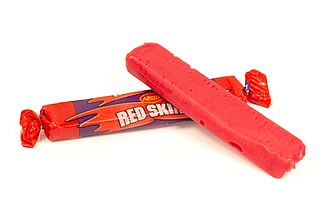
Confectionery is the art of making confections, which are food items that are rich in sugar and carbohydrates. Exact definitions are difficult. In general, however, confectionery is divided into two broad and somewhat overlapping categories: bakers' confections and sugar confections. The occupation of confectioner encompasses the categories of cooking performed by both the French patissier and the confiseur.

Liquorice or licorice is the common name of Glycyrrhiza glabra, a flowering plant of the bean family Fabaceae, from the root of which a sweet, aromatic flavouring is extracted.

Haribo GmbH & Co. KG, doing business as Haribo, is a German confectionery company founded by Hans Riegel Sr. It began in Kessenich, Bonn, Germany. The name "Haribo" is a syllabic abbreviation formed from Hans Riegel Bonn. The company created the first gummy candy in 1922 in the form of little gummy bears called Gummibärchen. The current headquarters are in Grafschaft, Germany.

Gummy bears are small, fruit gum candies, similar to a jelly baby in some English-speaking countries. The candy is roughly 2 cm (0.8 in) long and shaped in the form of a bear. The gummy bear is one of many gummies, popular gelatin-based candies sold in a variety of shapes and colors.

Nestlé Candy Shop was a confectionery brand owned and licensed by the Swiss corporation Nestlé. In 2018, the branding and production rights were sold to the Ferrero Group, and as a result, the brand was discontinued.

Salty liquorice, salmiak liquorice or salmiac liquorice, is a variety of liquorice flavoured with salmiak salt, and is a common confection found in the Nordic countries, Benelux, and northern Germany. Salmiak salt gives salty liquorice an astringent, salty taste, akin to that of tannins—a characteristic of red wines, which adds bitterness and astringency to the flavour. Consuming salmiak liquorice can stimulate either a savoury or non-savoury palate and response. Anise oil can also be an additional main ingredient in salty liquorice. Extra-salty liquorice is additionally coated with salmiak salt or salmiak powder, or sometimes table salt.
Crunchie is a brand of chocolate bar with a honeycomb toffee centre. It is made by Cadbury but was originally launched in the UK by J. S. Fry & Sons in 1929.

Liquorice allsorts are assorted liquorice confectionery sold as a mixture. Made of liquorice, sugar, coconut, aniseed jelly, fruit flavourings, and gelatine, they were first produced in Sheffield, England, by Geo. Bassett & Co Ltd.

Wine gums are chewy, firm pastille-type sweets originating from the United Kingdom. All brands have their own recipes containing various sweeteners, flavourings and colourings. Wine gums are popular in the United Kingdom, Canada, Ireland, South Africa and many Commonwealth nations, as well as several European countries. Common brands include Maynards, Bassett's, Haribo and Lion.

Liquorice or licorice is a confection usually flavoured and coloured black with the extract of the roots of the liquorice plant Glycyrrhiza glabra.

Trolli is a German manufacturer of confectionery. Its American arm was sold in 1996 and became a confectionery brand used by Ferrara Candy Company. Trolli sells gummy candies, marshmallows, and soft licorice gums in over 80 countries and has factories in Germany, Spain, Indonesia, the United States, China and the Czech Republic.
Fruit-tella are chewy sweets similar to Sugus, Starburst and Chewits. They are made using real fruit juice, natural colours and natural flavours, sugar and gelatine. They are made by Perfetti Van Melle, the company that also manufactures Mentos and Chupa Chups.

George Bassett & Co., known simply as Bassett's, was a British confectionery company and brand. The company was founded in Sheffield by George Bassett in 1842. The company became a brand of Cadbury Schweppes in 1989. The brand's final owner was Mondelēz International, which merged the brand with Maynards to create Maynards Bassetts in 2016.

Midget Gems are chewy, firm sweets similar to wine gums but much harder. They are manufactured from sugar and glucose syrup, corn starch and/or various other starches, animal gelatin, and various colourings and flavouring.

Red Ripperz are a red, raspberry-flavoured chewy confectionery manufactured in Australia by Nestlé under their Allen's brand.

Sherbet is a fizzy, sweet powder, usually eaten by dipping a lollipop or liquorice, using a small spoon, or licking it from a finger.

Gummies, gummi candies, gummy candies, or jelly sweets are a broad category of gelatin-based chewable sweets. Gummy bears, Sour Patch Kids, and Jelly Babies are widely popular and are a well-known part of the sweets industry. Gummies are available in a wide variety of shapes, most commonly seen as colorful depictions of living things such as bears, babies, or worms. Various brands such as Bassett's, Haribo, Albanese, Betty Crocker, Hersheys, Disney and Kellogg's manufacture various forms of gummy snacks, often targeted at young children. The name "gummi" originated in Germany, with the term "jelly sweets" more common in the United Kingdom.

Katjes International GmbH & Co. KG, headquartered in Emmerich am Rhein, is part of the Katjes Group, along with its sister company Katjes Fassin GmbH + Co. KG and Katjesgreenfood GmbH & Co. KG. The company is focused on investments in the Western European sugar confectionery market.



















